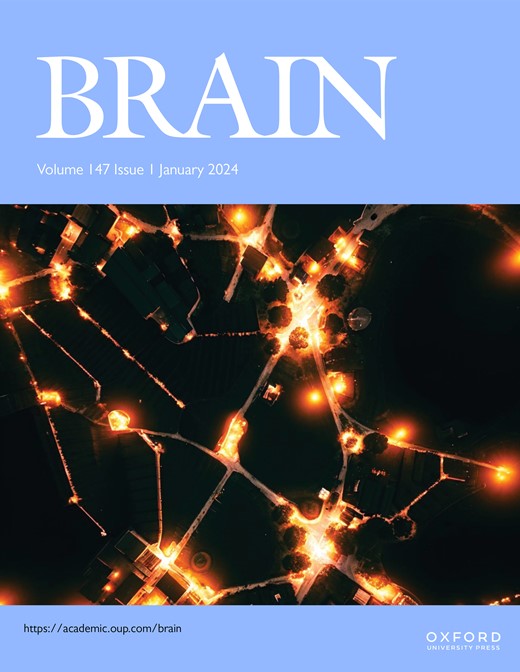Collapse of interictal suppressive networks permits seizure spread
IF 11.7
1区 医学
Q1 CLINICAL NEUROLOGY
引用次数: 0
Abstract
How do brain networks limit seizure activity? In the Interictal Suppression Hypothesis, we recently postulated that high inward connectivity to seizure onset zones (SOZs) from non-involved zones (NIZs) is a sign of broader network suppression. If broad networks appear to be responsible for interictal SOZ suppression, what changes during seizure initiation, spread, and termination? For patients with drug-resistant epilepsy, intracranial monitoring offers a view into the electrographic networks which organize around and in response to the SOZ. In this manuscript, we investigate network dynamics in the peri-ictal periods to assess possible mechanisms of seizure suppression and the consequences of this suppression being overwhelmed. Peri-ictal network dynamics were derived from stereo electroencephalography recordings from 75 patients with drug-resistant epilepsy undergoing pre-surgical evaluation at Vanderbilt University Medical Center. We computed directed connectivity from 5-second windows in the periods between, immediately before, during, and after 668 seizures. We aligned connectivity matrices across seizures and patients, then calculated net connectivity changes from the SOZ, propagative zone, and NIZ. Across all seizure types, we observed two phases: a rapid increase in directed communication towards the SOZ followed by a collapse in network connectivity. During this first phase, SOZs could be distinguished from all other regions (One-Way ANOVA, P-value = 8.32x10-19-2.22x10-7). In the second phase and post-ictal period, SOZ inward connectivity decreased yet remained distinct (One-Way ANOVA, P-value = 2.58x10-10-1.66x10-2). NIZs appeared to drive increased SOZ connectivity while intra-NIZ connectivity concordantly decreased. Stratifying by seizure subtype, we found that consciousness-impairing seizures decrease inward connectivity from the NIZ earlier than consciousness-sparing seizures (one-way ANOVA, p<0.01 after false discovery correction). Tracking network reorganization against a surrogate for seizure involvement highlighted a possible antagonism between seizure propagation and the NIZ’s ability to maintain high connectivity to the SOZ. Finally, we found that inclusion of peri-ictal connectivity improved SOZ classification accuracy from previous models to a combined area under the curve of 93%. Overall, NIZs appear to actively increase inhibitory signaling towards the SOZ during seizure onset, possibly to thwart seizure activity. While inhibition appears insufficient to prevent seizure onset, the inability to restrict seizure propagation may contribute to loss of consciousness during larger seizures. Dynamic connectivity patterns uncovered in this work may: i) facilitate accurate delineation of surgical targets in focal epilepsy, ii) reveal why interictal suppression of SOZs may be insufficient to prevent all seizures, and iii) provide insight into mechanisms of loss of consciousness during certain seizures.间隔性抑制网络的崩溃使癫痫蔓延
大脑网络如何限制癫痫发作?在间隔抑制假说中,我们最近假设,从非相关区(NIZs)到癫痫发作区(SOZs)的高度内向连通性是更广泛的网络抑制的标志。如果广泛的神经网络似乎对间隔性SOZ抑制起作用,那么在癫痫发作的开始、扩散和终止过程中有什么变化?对于耐药癫痫患者,颅内监测提供了一个关于围绕SOZ组织并响应SOZ的电图网络的视图。在这篇论文中,我们研究了周期性的网络动态,以评估癫痫发作抑制的可能机制和这种抑制被淹没的后果。在范德比尔特大学医学中心接受术前评估的75例耐药癫痫患者的立体脑电图记录显示,周神经网络动态变化。我们计算了668次癫痫发作之间、之前、期间和之后的5秒窗口的定向连接。我们在癫痫发作和患者之间对齐连接矩阵,然后计算从SOZ、传播区和NIZ的净连接变化。在所有癫痫发作类型中,我们观察到两个阶段:指向SOZ的定向通信迅速增加,随后是网络连接崩溃。在第一阶段,soz可以与所有其他区域区分开来(单向方差分析,p值= 8.32x10-19-2.22x10-7)。在第二阶段和后期,SOZ向内连通性下降,但仍然明显(单因素方差分析,p值= 2.58x10-10-1.66x10-2)。NIZs似乎推动了SOZ连通性的增加,而NIZs内部的连通性却一致下降。根据癫痫亚型进行分层,我们发现意识受损型癫痫发作比意识保留型癫痫发作更早地减少来自NIZ的内向连通性(单因素方差分析,错误发现纠正后0.01)。追踪网络重组与癫痫发作相关的替代物,强调了癫痫发作传播与NIZ保持与SOZ高度连接的能力之间可能存在的拮抗作用。最后,我们发现包含周向连通性将SOZ分类精度从以前的模型提高到曲线下的组合面积93%。总的来说,NIZs似乎在癫痫发作期间积极增加对SOZ的抑制信号,可能阻止癫痫发作活动。虽然抑制似乎不足以预防癫痫发作,但无法限制癫痫发作的传播可能导致更大的癫痫发作时意识丧失。在这项工作中发现的动态连接模式可能:i)有助于准确描述局灶性癫痫的手术目标,ii)揭示为什么间隔期抑制soz可能不足以预防所有癫痫发作,以及iii)为某些癫痫发作期间意识丧失的机制提供见解。
本文章由计算机程序翻译,如有差异,请以英文原文为准。
求助全文
约1分钟内获得全文
求助全文
来源期刊

Brain
医学-临床神经学
CiteScore
20.30
自引率
4.10%
发文量
458
审稿时长
3-6 weeks
期刊介绍:
Brain, a journal focused on clinical neurology and translational neuroscience, has been publishing landmark papers since 1878. The journal aims to expand its scope by including studies that shed light on disease mechanisms and conducting innovative clinical trials for brain disorders. With a wide range of topics covered, the Editorial Board represents the international readership and diverse coverage of the journal. Accepted articles are promptly posted online, typically within a few weeks of acceptance. As of 2022, Brain holds an impressive impact factor of 14.5, according to the Journal Citation Reports.
 求助内容:
求助内容: 应助结果提醒方式:
应助结果提醒方式:


